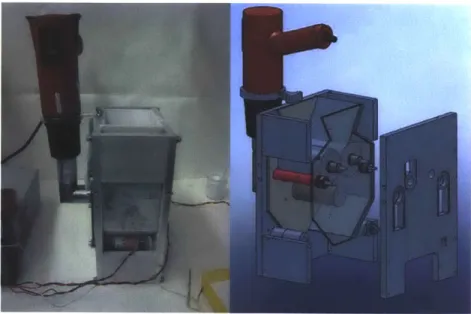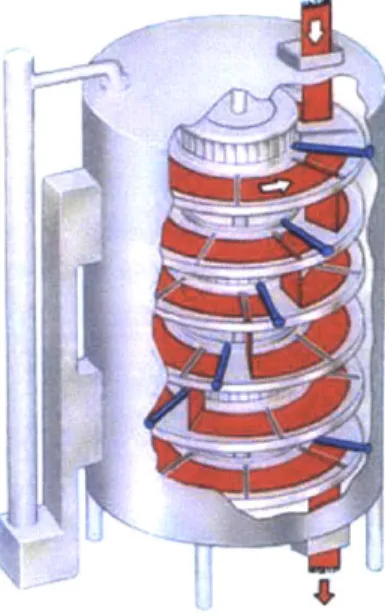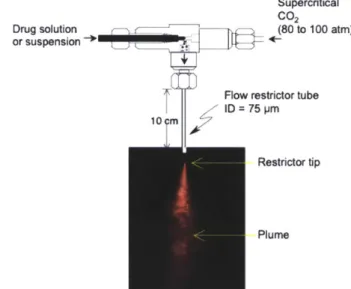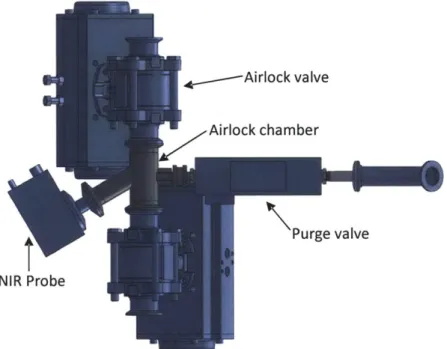Design of a rapid, continuous, small-scale device for creating
dry powders from concentrated suspensions containing active
pharmaceutical ingredients
By
Eric Owen Correll
SUBMITTED TO THE DEPARTMENT OF MECHANICAL ENGINEERING IN
PARTIAL FULFILLMENT OF THE REQUIREMENTS FOR THE DEGREE OF
BACHELOR OF SCIENCE IN MECHANICAL ENGINEERING
AT THE
MASSACHUSETTS INSTITUTE OF TECHNOLOGY
February 2011
C 2010 Eric Owen Correll. All rights reserved.
The author hereby grants to MIT permission to reproduce
and to distribute publicly paper and electronic
copies of this thesis document in whole or in part
in any medium now known or hereafter created.
Signature of Author:
9
Certified by:
k
MASSACHUSETTS INSTITUTE OF TECHNOLOGYOCT 2
0
2011
LIBRARIES
ARCHIVES
Iepaetient-of-Mechanical
Engineering
<2
January 14, 2011
Alexander H. Slocum
Pappalardo Professor of Mechanical Engineering
Thesis Supervisor
Accepted by:
John H. Lienhard V
Collins Professor of Mechanical Engineering
Chairman, Undergraduate Thesis Committee
Design of a rapid, continuous, small-scale device for creating dry powders from concentrated
suspensions containing active pharmaceutical ingredients
By
Eric Owen Correll
Submitted to the Department of Mechanical Engineering
on January 14, 2011 in partial fulfillment of the
requirements for the Degree of Bachelor of Science in
Mechanical Engineering
ABSTRACT
Current methods of producing pharmaceutical compounds are large batch processes. The
minimum time-to-patient for drug manufacturing is approximately 100 days. Using a continuous
manufacturing process, the time-to-patient could be reduced to less than ten days. The scope of
this paper encompasses the design of a machine for the desiccation of a mixture of solvent and
pharmaceutical compound. The goal of this project was to provide a small-scale, high throughput
method of continuous pharmaceutical drug drying for Novartis-MIT Center for Continuous
Manufacturing. Specifications included a product flow rate of 100 grams per hour and a final
product form of flowable powder. Several machines were built and tested, with the final design
being comprised of a convective drum dryer and a modular continuous vacuum dryer.
Thesis Supervisor: Alexander H. Slocum
Table of Contents
1. List of figures ... 4 2. Introduction...5 3. Design Goal ... 5 4. Drying M ethods...5 4.1. Flaking M ethod... 6 4.2. Vacuum M ethod... 8 4.3. Spraying M ethod ... 8 5. Final Design ... 9 5.1. Drum Dryer: ... 10 5.2. Screw Dryer:... 12 6. Conclusion ... 137. Acknow ledge m ents ... 14
8. References ... 14
9. Appendices ... 15
9.1. Screw housing m anufacturing drawing ... 15
9.2. Screw m anufacturing drawing ... 16
9.3. Residual solvent and purity for flat plate tests...17
1. List of figures
Figure 1: Rotary dryer and solid m odel ... 6
Figure 2: Drum dryer prototype and solid m odel ... 7
Figure 3: Sprayed product stuck to drying surface... 7
Figure 4: Turbo tray dryer(4)... 8
Figure 5: Supercritical carbon dioxide spray dryer schem atic (5) ... 9
Figure 6: Overall dryer schem atic ... 9
Figure 7: Drum dryer m odel show ing blades ... 11
Figure 8: Drum cross-section ... 11
Figure 9: Full screw dryer ... 12
Figure 10: Cross section of screw dryer housing w ith screw ... 12
Figure 11: Airlock w ith NIR probe... 13
2. Introduction
Current methods of producing pharmaceutical compounds are large batch processes. The minimum time-to-patient for drug manufacturing is approximately 100 days.(1) Using a continuous manufacturing process, the time-to-patient could be reduced to less than ten days. The scope of this paper encompasses the design of a machine for the desiccation of a mixture of solvent and pharmaceutical compound. The goal of this project was to provide a small-scale, high throughput method of continuous pharmaceutical drug drying for Novartis-MIT Center for Continuous
Manufacturing.
Current pharmaceutical manufacturing methods are focused on batch operations. The batch process allows for plant flexibility, using the machinery for several different products. Separate facilities are used for individual processes, such as chemical synthesis and tableting.(1) Because of the separation of facilities transport operations are required to move the material. This system is inefficient as it has several stages preparing and converting from transportable forms. A continuous manufacturing setting does not require extensive transport, or special transportable forms. This allows for significant time and
labor savings over a batch method.
This paper specifically focuses on continuous drying methods. The commercial food industry requires many of the same drying processes; however they have been converted to a continuous production method for efficiency.(2) Milk dehydration is particularly similar, as its initial and final forms are very similar. To that end industrial food-grade dryers were investigated and designs modified to fit the needs required by the Novartis- MIT Center for Continuous Manufacturing.
3. Design Goal
The design of this machine is specifically tailored to integrate into a lab scale continuous pharmaceutical manufacturing line. Design goals for the machine include:
1. Design must be continuous
2. Design must be capable of 100 grams per hour of product output.
3. Residual solvent content must be less that 5,000 parts per million, or as indicated by ICH
guidelines(3)
4. Material purity and crystalline structure must not be altered
5. Material must exit as a flowable powder
6. Residence time in the machine must be minimized 7. Physical size of machine must be minimized
8. Machine design must be novel to the pharmaceutical industry
4. Drying Methods
Several basic methods were investigated to determine the best method, or combination of methods to meet the design goals as stated in the previous section. This section will review the methods
and some prototypes used to test their feasibility. The methods investigated include flaking, vacuum drying, and spray drying. The methods are explained below.
4.1. Flaking Method
The flaking process starts by depositing the material onto a drying surface then using a contact removal method to turn the dry product into flakes. Having the product stuck to the drying surface allows for high velocity heated air to be used as the drying medium. High velocity air creates high heat transfer coefficients and can remove bulk solvent quickly. Three methods were investigated for material deposition, spreading, squeezing, and spraying.
To test the spreading method a rotary plate dryer was prototyped. A feeding tube with an adjustable orifice was used to deposit material, a temperature-controlled heat gun for the hot air source, and a spiral brush for the removal method. The rotary dryer prototype is shown in Figure 1. The spiral brush doubled as a conveying auger, and transported powder off the edge of the plate. The rotary plate dryer provided mechanical simplicity, as well as simple powder containment measures, as auger brush had a containment sheath. However, the spreading mechanism was not continuous, and plate deflection made process parameters difficult to control.
Figure 1: Rotary dryer and solid model
A drum dryer was designed to test the squeezing method for particle deposition. The material
was dropped onto the rollers, which squeezed the product to a thin film as a result of their counter-rotating motion. A heat gun attached to a diffuser supplied hot air across the surface of the drums, and rotating spiral brushes stripped the product from the drums. The drum dryer is shown in Figure 2. A continuous feeding method as easy adjustability for film thickness was provided by the drums. The structure of the dryer provided an easy structure for an enclosure. However the structure did not easily allow for separate drying and flaking chambers, leading to high levels of dust creation.
Figure 2: Drum dryer prototype and solid model
The rotary plate and drum dryers both used very similar techniques to create the end product. When tested, both machines yielded similar results, however the drum dryer created more dust. During the tests of these two machines the scraping brushes were observed to lose some of their bristles. The addition of particles to the product was unacceptable, and the brushes were discarded as a scraping mechanism. Although the rotary plate dryer produced less dust the drum dryer had a structure more easily suited for mounting of scraping devices, or other ancillary components.
A design using spray deposition was devised to create very thin films, which was thought to
dramatically decrease dry time. Initial tests showed that the spray nozzle was very prone to clogging. Any spray that was created was quickly dried on the drying surface; however the material was incredibly difficult to remove. Figure 3 shows a sample of the sprayed product on the drying surface. Because of the difficulty to remove the sprayed material from the drying surface, this method was abandoned.
4.2. Vacuum Method
Vacuum dryers are used in industry to get residual solvent contents to very small levels, less that
0.5%. A vacuum dryer has reduced heat transfer coefficients as compared to a convective dryer as it
lacks a heat transfer medium. Bulk solvent removal would not be effective in a vacuum dryer, as such; a vacuum dryer should be used as a secondary stage where the bulk solvent has already been driven off. To help with heat transfer, agitation is also needed. Existing continuous dryer designs are very large and complex. Large vacuum vessels require significant reinforcement to withstand the compressive external forces. Turbo tray dryers see Figure 4; have a complex conveying system inside of a vacuum chamber. Agitation occurs as the material drops from tray to tray. This design was deemed too complex for the timeline. A smaller auger style design was developed. A tubular housing would provide the vacuum chamber and a horizontal auger would convey the material. The exterior of the housing would be heated, and create the drying surface. Initial testing showed that an auger did not significantly agitate the powder as it conveyed it. This ensured a first in first out process, however hampered heat transfer. Although agitation was limited the complexity of the machine was appropriate for the available timeline.
LA
Figure 4: Turbo tray dryer(4)
4.3. Spraying Method
Spray dryers are currently used in industry, however they are quite large and lack continuous powder collection mechanisms. Spray dryers atomize the product, and dry it in a large column of heated air. The dust then travels through several filtration stages where it is collected. Initial investigation showed no benefit over the two stage flaking and vacuum stage drying, as a secondary vacuum stage was likely necessary. Upon further investigation a supercritical carbon dioxide drying method was found. Supercritical CO2 is an incredibly powerful solvent, capable of dissociating the solvent in the product from the product. Using this mixture in a spray dryer could remove all of the solvent virtually instantly, but would still require a continuous powder collection system. See Figure 5 for a schematic of a supercritical CO2 spray dryer. For this design to be feasible a continuous small-scale particulate collection system would need to be implemented. The equipment required for a continuous
supercritical dryer requires extensive design time, and a large footprint, for these reasons supercritical CO2dryers were not pursued for this project.
Drug solution or suspension +
Supercritical
Co2
(80 to 100 atm)
Flow restrictor tube ID = 75 pm
Restrictor tip
Plume
Figure 5: Supercritical carbon dioxide spray dryer schematic (5)
5. Final Design
The final design is a two-stage design made up of a drum dryer, utilizing the flaking method, and a tubular screw dryer utilizing the vacuum method. The function and design of each of these components is described in detail below. Figure 6 shows a schematic of the drying system.
5.1. Drum Dryer:
The goal for the drum dryer is to remove bulk solvent and convert the product to a form that can be handled by the second stage vacuum dryer. For a vacuum dryer to be effective large surface areas are necessary, demanding a powder with a large specific volume. The drum dryer consists of two counter-rotating drums which feed and spread material, see Figure 6. Headed air is blown from below at the intersection of the two drums. Blades are located on the far sides of the drums, which scrape the material off. The flakes fall from the blades and are funneled into the second stage. The drum dryer was designed with the ability to control various process parameters.
Initial testing for the drum dryer was carried out on a flat plate. The sides of the plate had adjustable spacers, allowing for different product thickness. The plate was covered and a temperature controlled blower placed at one end. Tests were carried out with different product thicknesses and blower temperatures. The samples were scraped off using a blade with different attack angles. The apparatus allowed for the testing of hot air temperature, residence time, product depth, and scraping angle. The flat plate did not allow for testing of the spreading mechanism. The product was spread onto the plate using a scraper, which rode on the spacers, thus setting product depth. The scraper used a shearing action to deposit material, which left a smooth surface. Testing of the prototype drum dryer resulted in peaks of material being formed on the rollers.
The overarching goal for the testing was to find the combination of parameters that would reach the lowest residual solvent content in the quickest time. The parameters that had the greatest impact on residual solvent were temperature and residence time. Thickness and blade angle had greater effects on final particle size. The material used for testing was 30%-40% solid loading, and had the consistency of a grainy whipped cream. Gas Chromatography was used to measure the residual solvent levels in the product. Samples were tested using temperatures from 500C to 800C, and residence times
from 30 seconds to two hours. The residual solvent content reached an asymptote at a residence time of four minutes at 800C, resulting in a residual solvent content of 4%. High temperatures led to glassing
in the product, where the outside of the crystal would melt, trapping solvent inside. As a result of the glassing, long drying times were experienced in the 2 nd stage vacuum dryer. The secondary drying time
with the glassed samples took up to 72 hours to reach an acceptable solvent level. The final outcome was to lower the drying temperature in the drum dryer to a maximum of 50*C with the residence time remaining at 4 minutes. This increased the solvent content into the second stage to 7%.
The final design for the drum dryer consists of two, eight inch diameter steel drums, using three inch wide doctor blades as the scraping mechanism. Figure 7 shows a model of the drum dryer. One of the drums is adjustable, to allow for variations in the solid loading of the product, and to optimize the design. Each of the drums is individually driven. This allows for greater movement between the drums without the need for additional adjustments. It also allows for the drums to be driven at different speeds. This would allow for some shearing action to be introduced into the spreading area, mimicking the smooth spreading observed in the flat plate testing.
Figure 7: Drum dryer model showing blades
The drums are made from 0.5" wall steel pipe segments, with drive flanges welded inside. The prototype design used solid steel 2.5" diameter drums. A solid 8.0" diameter drum is excessively heavy, thus a hollow design is necessary. The drums are supported by bearings located inside each end,
keeping them out of direct contact with the product. A cross-section of the drum is shown in Figure 8. Welded drive flanges
Bearing Drive shaft
Mounting flange
Figure 8: Drum cross-section
The doctor blade scrapers are tensioned to the drum using a large diameter cross shaft attached to a lever arm. A link connects the lever arm to the body of the dryer. Adjustment of this link varies the preload on the blades. Dual heaters are used to simplify plumbing, and allow for adjustment of flow characteristics within the machine.
5.2. Screw Dryer:
The goal for the screw dryer was to create a continuous vacuum oven with first in first out capabilities. Existing continuous vacuum oven designs use a conveyor housed inside a large vacuum chamber. The screw design uses the screw housing as a vacuum chamber, eliminating complexity. Simplicity of design was paramount as the machine needed to be in service in a very short time span. A complete view of the screw dryer is shown in Figure 9.
Figure 9: Full screw dryer
The design was tailored to a 12 hour residence time, as determined by batch vacuum oven testing experiments. The machine size was calculated using residence time and specific volume of the flakes from the first stage. Five stages each with 60.0" of drying length are required. Each of these sections are identical, allowing modularity, as well as ease of manufacture. Each stage is comprised of a stainless steel tubular housing with a 2.5 inch outer diameter. The housings connect together with standard QF vacuum fittings. Each housing has two small ports allowing for a vacuum pump and bleed connection. The ends of the housing are sealed with removable, flanges, allowing the screw to be removed from either end. A cross section of a housing is shown in Figure 10. Each housing has pad heaters affixed to length of its lower half.
Each module is driven by an independent motor, and has independent temperature control. This allows for temperature zones, and variable residence times. To achieve the designed residence time of 12 hours each screw will spin at 0.2 rpm. The screws are made from acetal to ensure bio-compliance if significant wear occurs, as well as chemical compatibility with ethyl acetate. The screws are unsupported other than by the Stainless housing. Because of their length and relatively small diameter multiple supports would be necessary along their length.
Airlocks are required at each end of the apparatus to ensure a continuous vacuum along its length. The airlocks function on their own dedicated vacuum system, to minimize fluctuations inside the chamber. The airlocks are comprised of two automated ball valves, and an automated three-way valve to purge and vent the chamber. The chamber size of the airlock provides the metering for the product. It is sized such that an entire pitch length of the screw is filled every cycle, which is every seven minutes.
Each airlock is equipped with a near infra red (NIR) spectrometer. This is used to measure incoming and outgoing solvent content, and to adjust residence times accordingly. The probe must be in contact with the product in order to take accurate measurements, however the product must also not pile up on the probe. To satisfy these requirements the probe is mounted at an angle, see Figure 11. The entire assembly is vertically stacked, such that gravity is used to transport material through the airlocks and from one stage to the next.
,---Airlock valve
Airlock chamber
Purge valve
NIR Probe
Figure 11: Airlock with NIR probe
6. Conclusion
The two-stage drying design has not yet been fully tested as a continuous process, however the design promises to improve upon the current batch drying methods. The design eliminates costly transport steps required by the current batch process and is designed with flexibility in mind. The flexibility of this design has already been shown in the early stages of testing. Design changes upstream
of the dryer required the incoming product to be changed from a paste to a suspension. The drum dryer was able to be quickly adjusted for this change and a re-design was not necessary. The flexibility of this first stage allows the same system to be used for different products.
Overall the system is not yet a substantial departure from existing technology, other than its continuous nature. The overall drying time is reduced, but not drastically. Future design work will
investigate supercritical CO2 drying, as it possesses the ability to dry the product almost instantaneously.
Technology currently exists for this drying method, however continuous collection methods do not.
7. Acknowledgements
This system was developed in collaboration with the Novartis-MIT Center for Continuous Manufacturing of the Novartis, and as a part of MIT course 2.75 Precision Machine Design
The author would like to thank Professor Alex Slocum, Keith Durand, James Evans, Salvatore Mascia, and Josh Dittrich for assistance with development and manufacturing. The author would also like to thank the former 2.75 team of Hao Ding, Kristopher Dos Santos, Aaron Ramirez, and Mohammad Imani for development of the rotary plate dryer and first revision of the drum dryer. The author is grateful for the support and facilities provided by the Edgerton Center and the MIT Motorsports team.
8. References
1. MIT-Novartis Center for Continuous Manufacturing. [Online] [Cited: December 12, 2010.]
http://ilp-www.mit.edu/images/conferencemedia/trout.pdf.
2. Mujumdar, A. S. Handbook of industrial drying. Boca Raton : CRC Press, 2007.
3. ICH. Impurities: Guidline for residual solvent. ICH. [Online] February 2009. [Cited: December 14,
2010.] http://www.ich.org/LOB/media/MEDIA5254.pdf.
4. Turbo-Dryer. Wyssmont. [Online] [Cited: December 14, 2010.] http://www.wyssmont.com/productdetail.php?section=Dryers&id=1.
5. CAN-BD Proccess. Activ-Dry. [Online] [Cited: December 14, 2010.] http://www.aktiv-d ry.com/ca nbhttp://www.aktiv-dprocess.html.
FLANGE
SIZE
MOUNING
COc$IG TUBE OD) (IN) ITUBE THK
FOCAL
POINT LENGTHFOCAL AZIMUTHALANGLE POLARANGLE
1 FL863 T 25 STANDARD 0 0 0 180 2 OF25 T I STANDARD 2.250 1150 0 90 3 OF63 T 25 STANDARD 5.625 2,750 0 90 4 OF63 T 2.5 STANDARD 65.25 2,750 180 90 5 OF25 T 1 STANDARD 69000 1.750 0 90 6 LF63 T 2.5 STANDARD 71,250 0 0 0 0 2.500 STANDARD THICKNESS AMERICAN HOLE ORIENTATION Poar=O-1.75 2.75 .4-i ~
SolidWorks Student License
Academic Use Only I
)4 t&...~: -f
MIT DRYER
AUGER HOUSING
MODULE
sD
G110
Io
ev
AIA
CA.f 1.8 IweG.~ I ~HW~ PORT vvl- - 1 - - I :::: . .... .. ... I I I I - - 11:111, ..::.. .: -:.,:::: - ,tr
I
65.25
60 L (y
DETAIL A SCALE I 2
DESCRPTION DIMENSION (IN) SCREW DIAMETER 2.313
ROOT DIAMETER 1.00 PITCH 1.50
FLIGHT LENGTH 65.25
RIGHT THICKNESS 100
FLIGHT MATERIAL DELRIN SHAFT LENGHT 750
SHAFT DIAMETER .625
SHAFT MATERIAL 304 STAINLESS
KEYWAY? NO OVERALL LENGTH 6.00
RIGHT/LEFT RIGHT
POLISHED I YES
SolidWorks Student License
Academic Use Only
'
NOTE FLUSH END CONDMON OF FLIGHT ON BOTH
ENDS-'o,-- A6
t #
P.,
MA
MIT DRYER
DRYER PLASTIC AUGER
SEE oG fo I BV SCAl.E: 18 t8G*T S siffr I Of 1 DETAIL 8 SCALE 1: 2 ... .. .. .... ... ... ... ... ..... . ... -.






